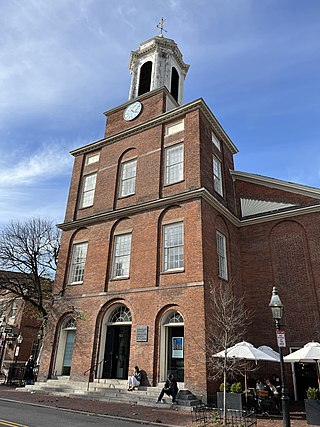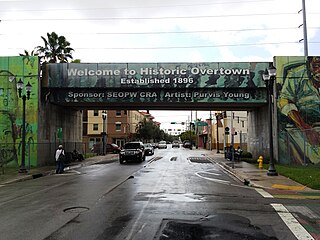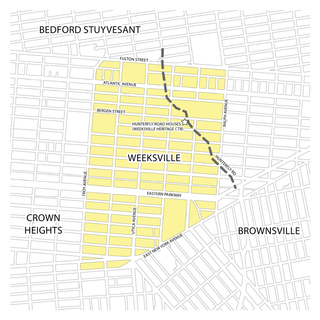
Eatonville is a town in Orange County, Florida, United States, six miles north of Orlando. It is part of Greater Orlando. Incorporated on August 15, 1887, it was one of the first self-governing all-black municipalities in the United States. The Eatonville Historic District and Moseley House Museum are in Eatonville. Author Zora Neale Hurston grew up in Eatonville and the area features in many of her stories.

The Charles Street Meeting House is an early-nineteenth-century historic church in Beacon Hill at 70 Charles Street, Boston, Massachusetts.

Overtown is a neighborhood of Miami, Florida, United States, just northwest of Downtown Miami. Originally called Colored Town in the Jim Crow era of the late 19th through the mid-20th century, the area was once the preeminent and is the historic center for commerce in the black community in Miami and South Florida.

America's 11 Most Endangered Places or America's 11 Most Endangered Historic Places is a list of places in the United States that the National Trust for Historic Preservation considers the most endangered. It aims to inspire Americans to preserve examples of architectural and cultural heritage that could be "relegated to the dustbins of history" without intervention.

Weeksville is a historic neighborhood founded by free African Americans in what is now Brooklyn, New York, United States. Today it is part of the present-day neighborhood of Crown Heights.

Sanibel Colored School, also known as Sanibel School, is a U.S. National Registered Historic school located in Sanibel, Florida. Starting all the way from 1914, schooling in Sanibel started from a Baptist church that James Johnson built on Sanibel Island. Thirteen years later, Johnson gave black families the opportunity to use the church for schooling for the children which later resulted in the Lee County Board of Public Instruction buying it for a little over $1,000. Schooling with them was a little bit different from regular schooling, because they only needed seven children in order to operate school with grades 1-8. With the population in Sanibel being 90 people, it was a little hard to keep up with the school because children were 9th-12th graders. A little after, it got to the point where the school had to close their doors. In the year of 1962, the Lee County School Board put the schools up for sale.
Samuel M. Plato (1882–1957) was an American architect and building contractor in the United States. His work includes federal housing projects and U.S. post offices, as well as private homes, banks, churches, and schools. During World War II, the Alabama native was one of the few African-American contractors in the country to be awarded wartime building contracts, which included Wake and Midway Halls. He also received contracts to build at least thirty-eight U.S. post offices across the country.

Bethel African Methodist Episcopal Church is a historic African Methodist Episcopal Church in Springtown, New Jersey, United States. The church was part of two free negro communities, Othello and Springtown, established by local Quaker families, like the Van Leer Family. The congregation was established in 1810 in Greenwich Township as the African Methodist Society and joined the African Methodist Episcopal Church in 1817. A previous church building was burned down in the 1830s in an arson incident and the current structure was built between 1838 and 1841.

West Badin Historic District is a national historic district located at Badin, Stanly County, North Carolina. The district encompasses 153 contributing buildings and 4 contributing sites in the company town of Badin. They were built starting about 1912 and include residential, institutional, and commercial structures in Gothic Revival and Bungalow / American Craftsman style architecture. The community was developed by the Southern Aluminum Company of America, later Alcoa, with West Badin developed for African-American residents. Notable buildings include the houses at 704 Roosevelt Street and 417 Jackson Street, 228-226 Lincoln Avenue duplex, Baptist Church, McDonald's Chapel AME Zion Church, and Badin Colored School.
The African American Cultural Heritage Action Fund is a program formed in 2017 to aid stewards of Black cultural sites throughout the nation in preserving both physical landmarks, their material collections and associated narratives. It was organized under the auspices of the National Trust for Historic Preservation. The initiative which awards grants to select applicants and advocates of Black history has been led by architectural historian Brent Leggs since 2019. It is the largest program in America to preserve places associated with Black history.

The Third Baptist Church, formerly the First Colored Baptist Church, is an American Baptist church founded in 1852, and located in the Western Addition neighborhood of San Francisco, California. It is the city of San Francisco's oldest African-American church. The church occupied several spaces in San Francisco over the course of its history. Since 1976, Rev. Amos C. Brown has been the pastor. It is affiliated with the American Baptist Churches USA.

















